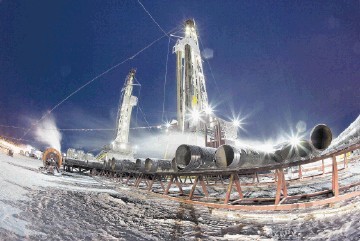
The US is producing the most oil in 31 years, economic growth is picking up and crude prices are plunging. So why is Americans’ use of petroleum waning?
As the US moves closer and closer to energy independence, greater fuel efficiency, changing demographics and an increase in renewables are altering the dynamic that in the past would have seen demand for gasoline climbing.
Gross domestic product, the value of all goods and services produced in the US, grew at a 2.4 % pace in the third quarter from the year-earlier period.
Oil consumption fell 0.3%, government data show.
“Oil demand and GDP growth used to go hand in hand,” Christopher Knittel, a professor of applied economics at Massachusetts Institute of Technology’s Sloan School of Management, said by phone from Cambridge, Massachusetts, December 8.
“Now, they’re in some ways almost independent of each other because of investments in fuel economy that tended to break the link.”
The shale boom has driven US output to the highest on a weekly basis since 1983, with oil production up 65% in just five years and the country supplying 89 percent of its own energy in 2014.
The US will export more energy than it imports by 2025, Wood Mackenzie Ltd said in an October research note.
The Energy Information Administration forecasts a 0.7% increase in demand next year; analysts surveyed expect the economy to expand four times faster.
Gasoline futures added 0.6% to $1.6518 a gallon in electronic trading on the New York Mercantile Exchange at 1:35 p.m. Singapore time.
Brent, the global oil benchmark, added 42 cents to $64.66 a barrel on the London-based ICE Futures Europe exchange.
Here’s an easier way to see how Americans are relying less on oil: 1,178 barrels were consumed a day for every $1 billion of GDP in September, down 33% from 1,760 barrels a day 20 years ago.
Some of those numbers are explained by the improving fuel economy in cars on US roads.
On average, automobiles sold in August could travel 25.8 miles on a gallon of fuel, up 28% since 2007, according to the University of Michigan’s Transportation Research Institute.
The production of biofuels is also playing a role by reducing the amount of petroleum in gasoline.
Ethanol now accounts for about a 10th of US motor fuel sales. Gasoline consumption has dropped 3.7% since 2010 even as the number of miles travelled on US highways rose 0.8%
Then there’s the effect of younger Americans moving to the city. The population in downtown areas grew at more than double the overall rate of US metropolitan areas from 2000 to 2010, according to the Census Bureau. More people living in city centers means more people who can get around without cars.
“There’s been a migration to inner cities by the youth and they’ve shunned cars,” Michael Morris, the US Energy Information Administration economist who prepares the nation’s petroleum demand forecasts, said by telephone December 8.
“The baby boomer cohort is retiring in much larger numbers.”
While oil drillers are clamping down on spending amid the lowest crude prices in five years, developers are investing more than $250 billion in 2014 on wind, solar and renewable resources, data compiled shows.
ConocoPhillips, based in Houston, cut its capital budget by 20% for next year, deferring spending in unconventional plays including the Niobrara in Colorado.
In the past five years, US renewable energy companies’ sales grew at a 49% annual rate while oil, gas and coal companies climbed 9.4%.
Renewable power production rose to a record 252 million megawatt-hours in 2013, data compiled shows.
Oil generated 13 million megawatt-hours, down 88% since 2003.
“When high sulfur fuel oil was abundant, it was a very good competition to coal in the power system,” Ed Morse, Citigroup Inc.’s head of commodities research, said December 5 by phone from New York. “Now we have virtually eliminated fuel oil production.”
The US energy boom has been driven by a combination of horizontal drilling and hydraulic fracturing, which has unlocked supplies from shale formations including the Bakken in North Dakota and the Eagle Ford in Texas.
The technique is typically more expensive than pumping from conventional reservoirs.
Higher production has allowed the US to import the least oil in almost two decades, build more chemical plants and increase fuel shipments abroad to 3.6 million barrels a day, the most in the world.
Combined with lower prices, rising output has spurred calls for the government to lift restrictions on most US crude exports.
Companies are investing $133 billion in the US chemical industry to take advantage of plentiful natural gas from shale formations in places like Pennsylvania and Texas, according to the American Chemistry Council.
And then there’s this twist in the energy independence story — lower crude prices could paradoxically weaken demand.
The argument goes like this: Declining oil will give consumers more disposable income that they can use to purchase more efficient vehicles, energy economist Philip Verleger said.
Likewise, airlines will reinvest profits made possible by cheaper fuel into new planes with economic engines, he said.
“Consumers are doing their best to get themselves out of buying petroleum products,” Verleger said. “The fall in oil prices is going to accelerate the fuel’s own demise.”
Recommended for you
